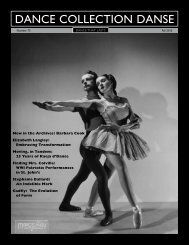DANCE COLLECTION DANSE
3E8Oe3fJp
3E8Oe3fJp
You also want an ePaper? Increase the reach of your titles
YUMPU automatically turns print PDFs into web optimized ePapers that Google loves.
Although several people considered Ballard to be<br />
next in line as artistic director – and she was certainly<br />
asked by the board to apply, more than once – she<br />
was conflicted by a lack of assurance that either she or<br />
Browne had any kind of a future with the company at<br />
all. In an act of defiance over how the search process was<br />
handled, Ballard withdrew her application and followed<br />
Browne out the doors at the end of the 1982/83 season.<br />
Facing the loss of the company structure in which she<br />
had thrived for the last eleven years, Ballard adjusted<br />
to a challenging new reality as an independent dance<br />
artist, leaning on her network for support. Since The<br />
White Goddess, Ballard had remained in close touch with<br />
dancer/choreographer Margie Gillis, whose solo career<br />
had by then earned her a reputation as an international<br />
superstar and beloved Canadian icon. Despite this, Gillis<br />
was seeking artistic advice and asked Ballard to come<br />
to Montreal to observe some of her work. An artistic<br />
exchange began to take shape and Ballard became Gillis’s<br />
artistic advisor and company manager for the next ten<br />
years. During a decade of working together, Ballard also<br />
set several of her own works on Gillis, including Lithium<br />
for Medea (1984) and Gillis’s signature solo, Mara (1989).<br />
Ballard was well recog nized for her success in the<br />
1980s, receiving the Clifford E. Lee Choreography<br />
Award in 1982, the Jean A. Chalmers Award in 1985<br />
and the Jacqueline Lemieux prize in 1986. And, though<br />
she worked closely with Gillis and lived with her parttime<br />
in Montreal, Ballard spread her talent and energy<br />
across North America like creative wildfire. By 1986,<br />
Starrett had been appointed artistic director of South<br />
Carolina’s Columbia City Ballet and began commissioning<br />
Ballard to set some of her modern work on the<br />
company. Keeping to her roots, she also maintained<br />
an apartment in Winnipeg (which she rented to visiting<br />
artists) and occasionally returned to create work<br />
such as Trouble in the House (1986), Anna (1987) and<br />
Continuum (1990). Of particular note is Continuum, an<br />
expression of artistic and feminine lineage set on several<br />
dancers from Ballard’s past including Thomson,<br />
Petursson-Hiley, Rabin, Gillis, WCD dancers D-Anne<br />
Kuby and Ruth Cansfield and, of course, Browne.<br />
Ballard admits that, at the age of forty, she was<br />
thinking heavily about the concept of continuum<br />
that year. Having graduated from the apprentice<br />
program with Thomson in 1972 and watched other<br />
colleagues follow closely behind, Ballard was struck<br />
by the interconnectedness of their paths. Reflecting<br />
on her family of dancers and the artistic and feminine<br />
histories that connect them, Ballard wrote in the program<br />
notes that Continuum celebrates “an energized<br />
dance relationship between dance artists that I have<br />
worked with, some for as long as eighteen years.”<br />
This theme of heritage and legacy would become<br />
a cornerstone of Ballard’s career. In the mid-nineties,<br />
Ballard embarked on an extensive project with the<br />
intention to explore and document several overlapping<br />
concepts of personal legacy. The Legacy Project,<br />
as it was called, involved not only the revisiting and<br />
documentation of Ballard’s artistic history but also the<br />
exploration of movement as a form of revealing legacy<br />
itself – a way in which, working from the inside out, she<br />
feels we simultaneously discover and express ourselves<br />
by exploring movement patterns and impulses<br />
Rachel Browne in Stephanie Ballard’s Homeagain (2010)<br />
Photo: Vince Pahkala<br />
36 Dance Collection Danse




